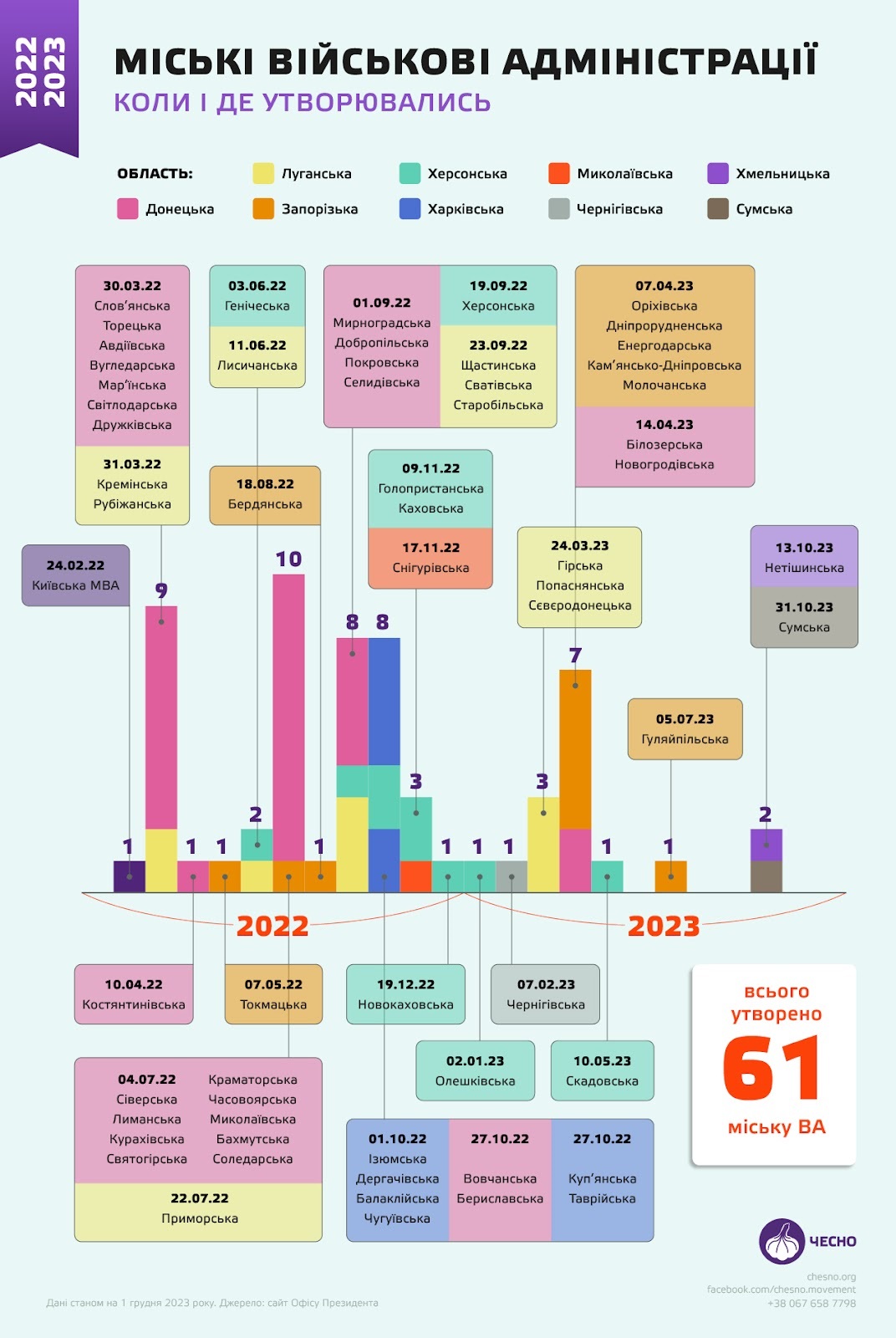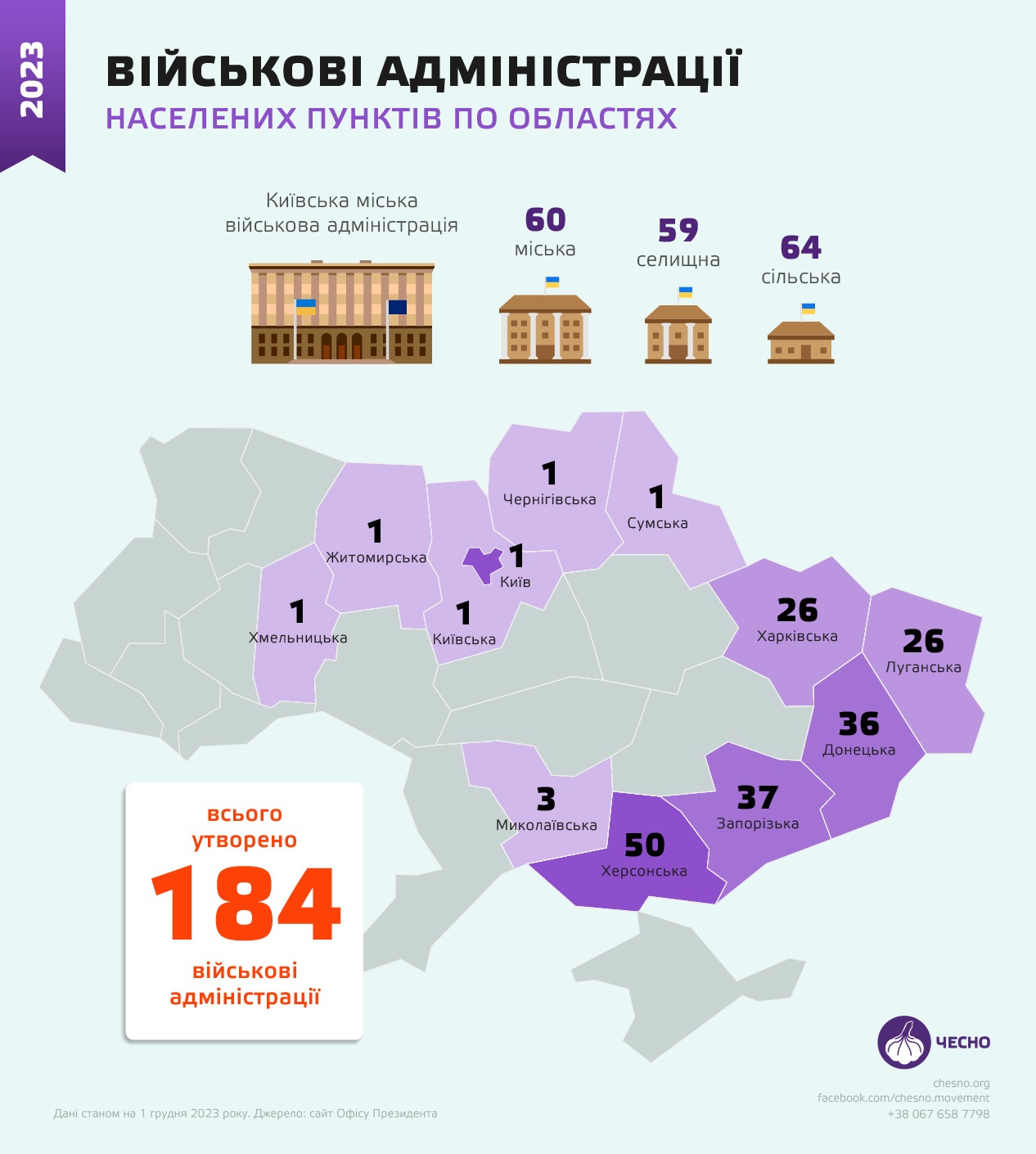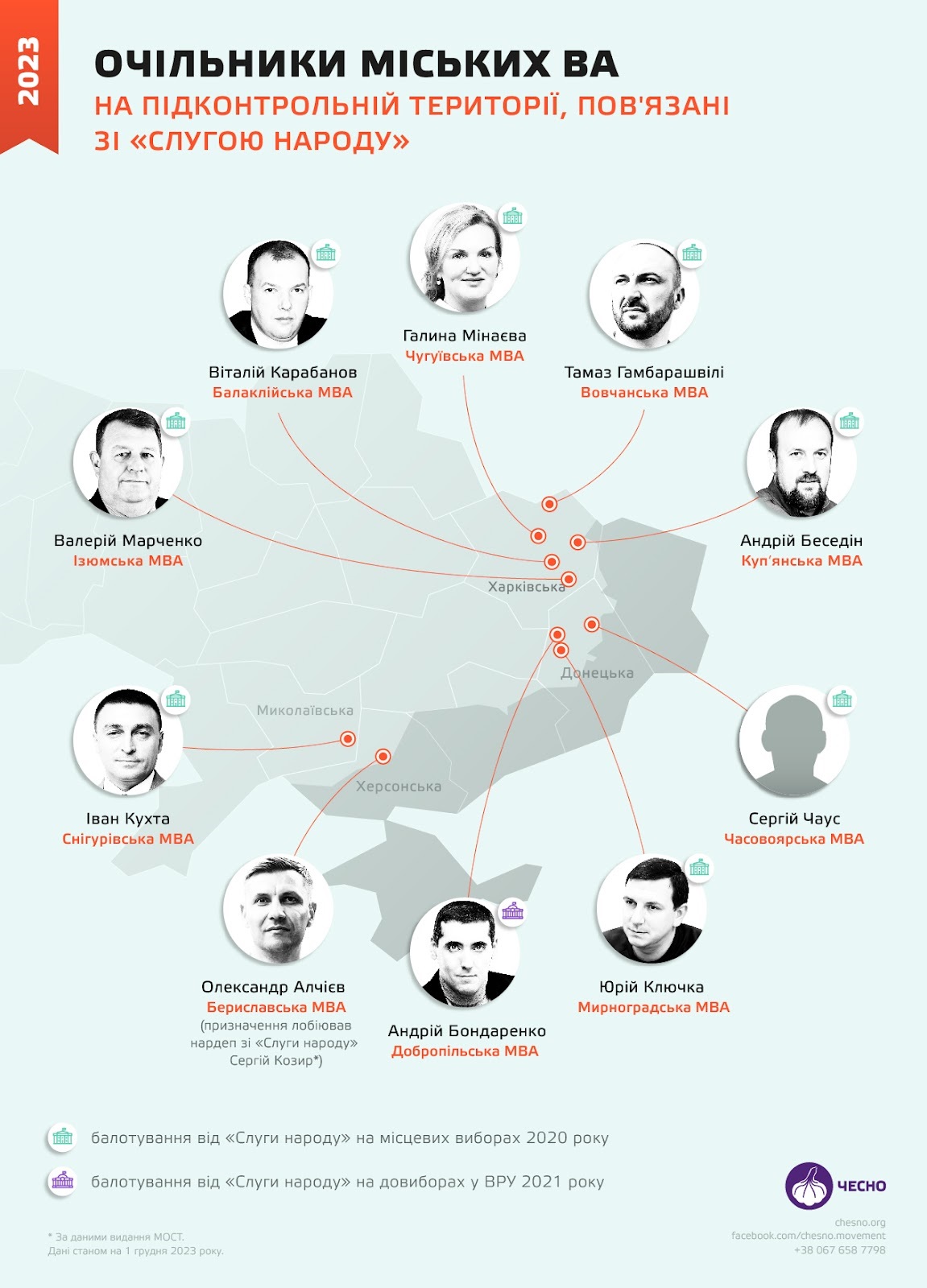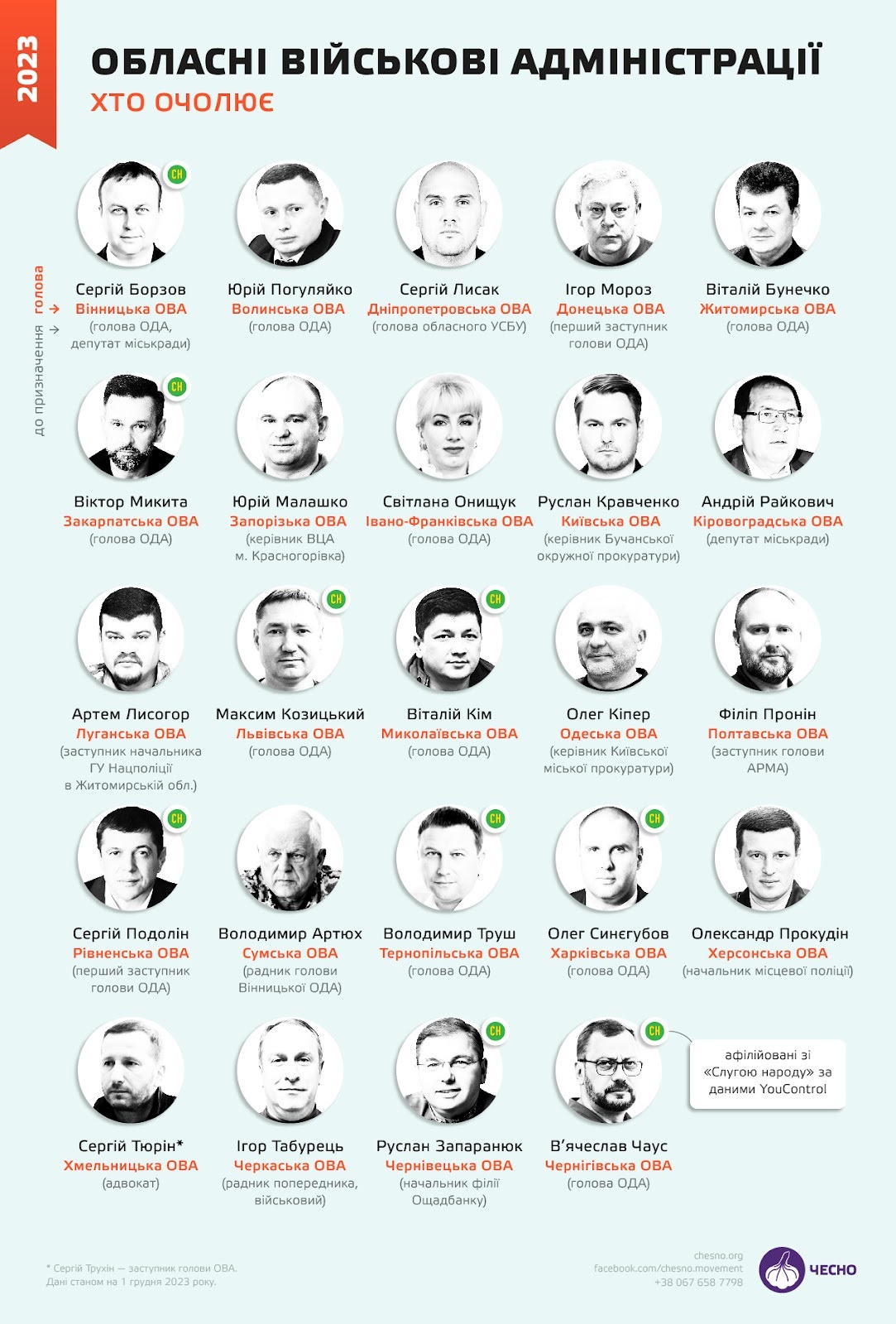В Украине сейчас действует множество военных администраций, но их руководители различаются. Одним из возможных руководителей может быть министр обороны Украины. Также военные администрации могут быть возглавлены высокопоставленными офицерами или командирами военных подразделений.
Военные администрации являются важным инструментом осуществления управления в регионах и общинах во время военного положения. В то же время они могут представлять серьезную угрозу местному самоуправлению, ведь позволяют «переиграть» результаты местных выборов в пользу президентской партии.
Так, по результатам местных выборов ни один представитель «Слуги народа» не стал мэром областного центра. Однако сейчас с этой политсилой связана треть глав военных администраций в городах, которые не являются оккупированными или на территории которых не ведутся боевые действия. Кроме того, десять глав областных военных администраций являются представителями «Слуги народа» или аффилированы с ней.
Где были созданы военные администрации, кто их возглавляет и как это позволяет главе государства формировать свою вертикаль в регионах, разбиралось Движение «Честно».
Где созданы военные администрации
Исчерпывающий список военных администраций с данными об их руководителях найти невозможно. Есть только указы об их создании на сайте Офиса президента. Согласно этим документам, в Украине сейчас действуют 183 военные администрации населенных пунктов, еще 24 — в областях, одна — в Киеве. Также военные администрации были образованы на базе существующих районных государственных администраций.

Первой военной администрацией, которая была создана после начала полномасштабного вторжения России (не считая образованные на базе госадминистраций), стала Гостомельская. Соответствующий указ президент Владимир Зеленский подписал 21 марта 2022 года. Это единственная военная администрация населенного пункта в Киевской области. Все остальные являются районными, как, например, Бучанская. Последней была создана Сумская городская военная 31 администрация — в октябре этого года.
Больше всего военных администраций создано в Херсонской области — 50. В Запорожской области — 37, а в Донецкой — 36. Довольно неожиданным было создание военной администрации в Нетешине Хмельницкой области, за сотни километров от зоны боевых действий. Это произошло 13 октября 2023 года, в годовщину начала обстрелов критической инфраструктуры. Возглавил ее Григорий Олендра. Именно в Нетешине расположена Хмельницкая атомная электростанция.

Военные администрации сейчас действуют в 61 городе (учитывая Киев), еще 59 — в поселках, 64 — в селах. При этом работа почти половины городских военных администраций невозможна из-за оккупации этих населенных пунктов. Часто такие администрации работают в других городах на подконтрольной территории.
Военные администрации должны образовываться там, где органы местного самоуправления не могут выполнять свои обязанности. Это актуально для ряда общин вблизи линии фронта. Тогда там образуется военная администрация, а ее глава фактически самостоятельно управляет городом. Главу назначает Зеленский по представлению Генштаба ВСУ или областной военной администрации. Передачу полномочий местных органов должна поддержать Верховная Рада.
Городские военные администрации
Выборы 2020 года не стали громким успехом для «Слуги народа». Тогда ни в одном областном центре партии не удалось получить кресло мэра. Большинства в областных или городских советах «слуги» также не получили.
Но создание военных администраций и расширение полномочий их руководителей открыло окно возможностей для усиления влияния президента.
Так, в законе «О правовом режиме военного положения» предусмотрено, что военные администрации могут осуществлять полномочия не только городских, поселковых или сельских советов, но и областных и районных (статья 10).
Хотя руководителей военных администраций назначает Зеленский, не все они являются представителями «Слуги народа». Мало того, не все из них являются политиками, ведь эту должность могут занимать и военные.
Однако из 30 военных администраций в городах, которые не являются оккупированными или на территории которых не ведутся активные военные действия, по меньшей мере десять возглавляют люди, связанные со «Слугой народа». Половина таких — на Харьковщине.

Часть баллотировались от этой партии, а часть аффилированные. Так, например, Бериславскую городскую военную администрацию на Херсонщине возглавляет Александр Алчиев. С 2010 по 2017 год он был сельским головой Раздольного в Донецкой области, то есть в совершенно другой области. Сначала он баллотировался от Партии регионов, затем — от «Блока Петра Порошенко».
Однако, по данным регионального издания «Мост», на должность сначала заместителя председателя Бериславской районной военной администрации, а затем и начальника городской он был назначен по так называемой квоте нардепа от «слуг» Сергея Козыря.
Иная история в Мирнограде Донецкой области: там военную администрацию возглавляет Юрий Ключка. В 2020 году он неудачно баллотировался в горсовет от «Слуги народа», однако впоследствии возглавил Покровскую райгосадминистрацию. В мае после начала полномасштабного вторжения он сложил полномочия и ушел в тероборону. Военную администрацию города возглавил уже в сентябре, когда она была создана.
Еще несколько руководителей городских военных администраций были связаны с запрещенным в 2022 году «Оппозиционным блоком» — все в Донецкой области. Так, Славянскую МВА возглавляет Вадим Лях, который в 2020 году был избран мэром города от этой же партии. А главой военной администрации в Дружковке стал Сергей Боевский, который до того был заместителем председателя Покровского районного совета. В 2015 году на местных выборах он баллотировался именно от Оппоблока.
Среди глав городских военных администраций есть и политик, связанный с «Европейской солидарностью». Речь идет о Сергее Добряке, который руководит Покровской администрацией. В 2020 году он баллотировался и был избран в районный совет именно от этой партии.
Большинство руководителей городских военных админитсраций до назначения на должность были мэрами. Шестеро из них были самовыдвиженцами. Однако если в прифронтовых городах администрации в основном все равно возглавляют политики или чиновники, то ситуация с областными центрами или уже упомянутым Нетешином несколько иная.
Городские военные администрации сейчас действуют в Херсоне, Сумах и Чернигове. Их руководители относятся к военным структурам, а некоторые назначения сопровождались скандалами. Также военная администрация есть в Киеве, однако эта история осложняется особым статусом города.
Особенно известен стал случай Чернигова. Год назад мэра Владислава Атрошенко отстранили от должности. Уже в феврале Зеленский подписал указ о создании в городе военной администрации, которую возглавил Дмитрий Брижинский.
В Сумах военную администрацию также возглавляет военный — Алексей Дрозденко. С началом полномасштабного вторжения он вступил в ряды ТРО и участвовал в организации обороны города. Однако до этого он не был политиком или чиновником. а работал в университете.
Областные военные администрации и Киев
Областные военные администрации образовали 24 февраля 2022 года на базе существующих в то время государственных администраций. В основном их возглавили те же люди, что и до полномасштабной войны. Их полномочия расширились, а медийность выросла. Сейчас десять ОГА возглавляют те же люди, которые раньше руководили госадминистрациями.

Восемь глав областных военных администраций являются представителями «Слуги народа» или связаны с ней. Так, Максим Козицкий возглавляет Львовскую областную ячейку партии. На прошлых местных выборах Львов стал едва ли не самым большим поражением для президентской силы, а вот увеличение влияния руководителей военных администраций позволяет это изменить. Так, еще в начале полномасштабного вторжения, в мае 2022 года, по данным социологической группы «Рейтинг», действия мэра города Андрея Садового и Максима Козицкого поддерживало почти одинаковое количество людей.
Если Козицкий возглавлял партийную ячейку и до начала большой войны и создания военной администрации, то в Черниговской области другая история. Ее начальник Вячеслав Чаус до того был на должности руководителя ОГА, но «Слугу народа» в регионе возглавил только в 2023 году по распоряжению председателя партии Елены Шуляк. Произошло это в конце января, за неделю до образования Черниговской городской военной администрации.
А вот Черновицкую область сейчас возглавляет Руслан Запаранюк. В 2020 году он баллотировался в местный совет от партии «Единая альтернатива», однако выборы тогда проиграл. И вплоть до назначения на нынешнюю должность в 2022 году возглавлял черновицкий филиал «Ощадбанка». Этой осенью он также возглавил областную ячейку «Слуги народа». То есть сформировалась определенная практика: сначала назначать начальников администраций, а после этого вводить их в партийную структуру.
Андрей Райкович, который возглавляет Кировоградскую область, официально отношения к «слугам» не имеет. На прошлых местных выборах он баллотировался на должность мэра Кропивницкого от «Пропозиции». Однако уже в этом году вместе с председателем облсовета от «Слуги народа» Дроздом был замечен за гречкосейством — раздавали учителям ноутбуки, приобретенные за средства спонсоров.
Единственная областная военная администрация, которая сейчас не имеет руководителя, — Хмельницкая. Его обязанности исполняет заместитель председателя Сергей Тюрин — с марта этого года, после увольнения Сергея Гамалия.
Едва ли не самое ожесточенное противостояние между президентской вертикалью и местным самоуправлением происходит в Киеве. По логике, Киевская городская военная администрация должна была бы быть создана на базе уже существующей государственной администрации, которую возглавляет Виталий Кличко, мэр столицы. Однако по факту эти два органа существуют параллельно.
КГВА сейчас возглавляет Сергей Попко — военнослужащий, генерал-полковник ВСУ, который был назначен на должность в октябре 2022 года. Не будучи политиком или партийцем, он фактически представляет центральную власть в Киеве.
Разграничение его обязанностей и обязанностей Кличко, по сути, существует лишь на словах. Поэтому регулярно поднимается вопрос целесообразности существования военной администрации в столице. Непонятно, кому подчиняются районные администрации в городе, из-за чего возникают, например, ситуации с переброской ответственности за неподготовку укрытий, в результате чего погибли люди. Эти вопросы должен был бы урегулировать новый закон о столице, принятие которого нардепы значительно оттягивают.
Сейчас количество руководителей военных администраций, связанных со «Слугой народа», является значительным. Иногда оно увеличивается из-за того, что начальников военных администраций назначают также и на должности в партии. Это стало довольно мощным инструментом, позволяющим «слугам» увеличивать свое влияние на местах.
Движение «Честно» уже отмечало, что Верховная Рада должна разграничить полномочия центральной и местной власти. В том числе сформировать четкие критерии оснований для создания военных администраций и определить, где проходят границы влияния президента на их руководителей. И чем дальше, тем насущнее возникает потребность в этом, чтобы сохранить достижения децентрализации.


